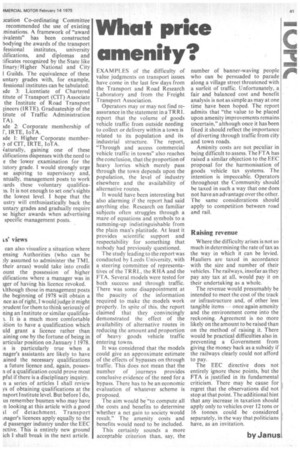What price amenity?
Page 43

If you've noticed an error in this article please click here to report it so we can fix it.
EXAMPLES of the difficulty of value judgments on transport issues have come in the last few days from the Transport and Road Research Laboratory and from the Freight Transport Association.
Operators may or may not find reassurance in the statement in a TR R L report that the volume of goods vehicle traffic from outside needing to collect or delivery within a town is related to its population and its industrial structure. The report, "Through and access commercial vehicle traffic in towns" also reaches the conclusion, that the proportion of heavy lorries which merely pass through the town depends upon the population, the level of industry elsewhere and the availability of alternative routes.
It would have been interesting but also alarming if the report had said anything else, Research on familiar subjects often struggles through a maze-of equations and symbols to a summing-up indistinguishable from the plain man's platitude. At least it provides scientific support and respectability for something that nobody had previously questioned.
The study leading to the report was conducted by Leeds University, with a steering committee of representatives of the TR R L, the R HA and the ETA. Several models were tested for both success and through traffic.
• There was some disappointment at the paucity of the information required to make the models work properly. In spite of this, the report claimed that they convincingly demonstrated the effect of the availability of alternative routes in reducing the amount and proportion of heavy goods vehicle traffic entering towns.
It was considered that the models could give an approximate estimate of the effects of bypasses on through traffic. This does not mean that the number of journeys provides conclusive evidence of the need for a bypass. There has to be an economic evaluation of whatever scheme is proposed.
The aim would be "to compute all the costs and benefits to determine whether a net gain to society would result." The amenity costs and benefits would need to be included.
This certainly sounds a more acceptable criterion than, •say, the number of banner-waving people who can be persuaded to parade along a village street threatened with a surfeit of traffic. Unfortunately, a fair and balanced cost and benefit analysis is not as simpleas may at one time have been hoped. The report admits that "the value to be placed upon amenity improvements remains uncertain," although once it has been fixed it should reflect the importance of diverting through traffic from city and town roads.
Amtnity costs are not peculiar in being difficult to assess. The ETA has raised a similar objection to the EEC proposal for the harmonisation of goods vehicle tax systems. The intention is impeccable. Operators throughout the Community should be taxed in such a way that one does not have an advantage over the other. The same considerations should apply to competition between road and rail.
Raising revenue
Where the difficulty arises is not so much in determining the rate of tax as the way in which it can be levied. Hauliers are taxed in accordance with the size and number of their vehicles. The railways, insofar as they pay any tax at all, would pay it on their undertaking as a whole.
The revenue would presumably be intended to meet the cost of the track or infrastructure and, of other less tangible items once again amenity and the environment come into the reckoning. Agreement is no more likely on the amount to be raised than on the method of raising it. There would be practical difficulties also in preventing a Government from giving the money back as a subsidy if the railways clearly could not afford to pay.
The EEC directive does not entirely ignore these points, but the FTA is justified in its fundamental criticism. There may be cause for regret that the observations did not stop at that point. The additional hint that any increase in taxation should apply only to vehicles over 12 tons or 16 tonnes could be considered separately, in the way that politicians have, as an invitation.
by Janus




































































































